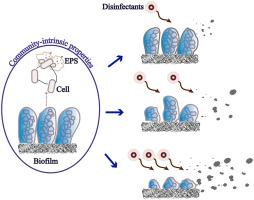Chemosphere ( IF 8.8 ) Pub Date : 2020-09-24 , DOI: 10.1016/j.chemosphere.2020.128410 Zebing Zhu , Lili Shan , Xinyun Zhang , Fengping Hu , Dan Zhong , Yixing Yuan , Jie Zhang

|
Community-intrinsic properties affect the composition and function of a microbial community. Understanding the microbial community-intrinsic properties in drinking water distribution systems (DWDS) could help to select disinfection strategies and aid in the prevention of waterborne infectious diseases. In this study, we investigated the formation of multi-species biofilms in six groups, each consisting of four or five mixed bacterial strains isolated from a simulated DWDS, at different incubation times (24, 48, and 72 h). We then evaluated the chlorine resistance of the 72-h multi-species biofilms in the presence of 0.3, 0.6, 1, 2, 4, and 10 mg/L residual chlorine. Microbacterium laevaniformans inhibited the formation of multi-species biofilms, Sphingomonas sp., Acinetobacter sp. and A. deluvii had the effect of promoting their growth, and B. cereus has little effect on the growth of multi-species biofilms. However, these inhibition and promotion effects were weak and inadequate to completely control the growth of multi-species biofilms. All multi-species produced strong biofilms after 72 h incubation, which could be due to microbial community-intrinsic properties. Community-intrinsic properties could maintain high EPS production and cell-to-cell connections in multi-species biofilms, and could affect the formation of multi-species biofilms. The chlorine resistance of multi-species biofilms was significantly improved by B. cereus, but significantly reduced by M. laevaniformans. These results indicated that the microbial community-intrinsic properties were influenced by the environment. At a relatively low disinfectant concentration (<2 mg/L residual chlorine), the community-intrinsic properties were maintained; however, when the disinfectant concentration was increased to 2–4 mg/L residual chlorine, the community-intrinsic properties weakened, and significantly affected the resistance of the microbial communities to the disinfectant. With further increases in concentration, to >4 mg/L residual chlorine, no significant difference was observed in the disinfectant resistance of the microbial community.
中文翻译:

饮用水分配系统中细菌群落组成和结构对生物膜形成和耐氯性的影响
社区固有属性会影响微生物社区的组成和功能。了解饮用水分配系统(DWDS)中的微生物群落本征特性可以帮助选择消毒策略,并有助于预防水传播的传染病。在这项研究中,我们调查了六组多物种生物膜的形成,每组由不同的孵育时间(24、48和72小时)从模拟DWDS中分离出的四到五种混合细菌菌株组成。然后,我们在残留氯含量为0.3、0.6、1、2、4和10 mg / L的情况下评估了72小时多物种生物膜的耐氯性。拟南芥微细菌可抑制多种生物膜Sphingomonas sp。,的形成,不动杆菌属 A. deluvii和A. deluvii具有促进其生长的作用,而蜡状芽孢杆菌对多物种生物膜的生长几乎没有影响。然而,这些抑制和促进作用是弱的并且不足以完全控制多种生物膜的生长。温育72小时后,所有多物种都产生了坚固的生物膜,这可能是由于微生物群落固有的特性所致。社区固有属性可以在多物种生物膜中维持较高的EPS产量和细胞间连接,并可能影响多物种生物膜的形成。蜡状芽孢杆菌显着提高了多种生物膜的耐氯性,但拉美尼莫尔氏菌却大大降低了其耐氯性。。这些结果表明,微生物群落固有特性受到环境的影响。在相对较低的消毒剂浓度(<2 mg / L残留氯)下,保持了社区固有的特性;但是,当消毒剂的浓度增加到残留氯2-4 mg / L时,群落内在特性减弱,并显着影响了微生物群落对消毒剂的抵抗力。随着浓度的进一步增加,至残留氯> 4 mg / L,在微生物群落的耐消毒性方面未观察到显着差异。



























 京公网安备 11010802027423号
京公网安备 11010802027423号